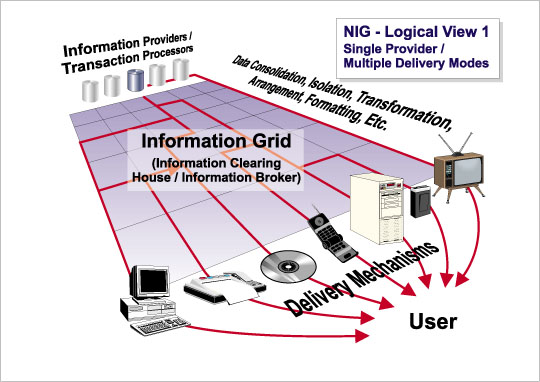2.2.1 Multiple Delivery Modes
One of the primary purposes of the NIG is to deliver information from a
provider to the user, regardless of the delivery mechanism or “terminal
type”. In order to do so, the grid must have the ability to retrieve
the desired information and prepare it in a format that is suitable for
delivery on the chosen mechanism or device. Figure 2-1 illustrates
the flexibility that this ability provides to both the IP and the user.
This ability to deliver information through various delivery mechanisms frees the user from having to use specific devices in order to retrieve data from specific information providers. It will also save the IPs the cost and effort to deliver their information through every applicable device type since the NIG operator will do it for them. The only restrictions will be those imposed by the technical designs of each type of information delivery device.

Figure 2-1. Flexibility of delivery through
various delivery mechanisms
An example of this delivery concept would be traffic advisory information.
A traffic advisory IP makes its information available to the NIG which
can then deliver it to users through various devices and formats as shown
in Table 2-2. It would be up to the user to choose the delivery mechanism.
| Delivery Mechanism | Delivery Format |
|---|---|
| Personal Computer | On-screen textual data |
| Telephone | Synthetic voice |
| Fax Machine | Printed textual data (and possibly graphics) |
| Data phones (future) | On-screen textual data |
| Multimedia PC with broadband network (future) | On-screen textual data, graphics and synthetic voice |
| Interactive TV (future) | On-screen textual data, graphics and synthetic voice |
